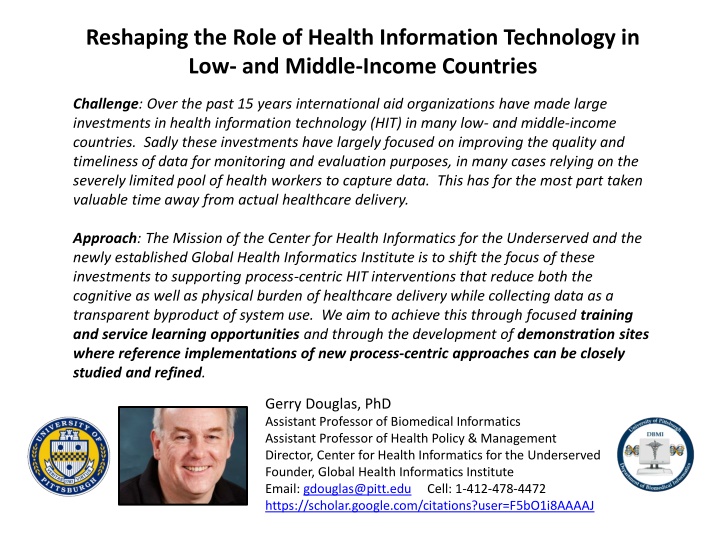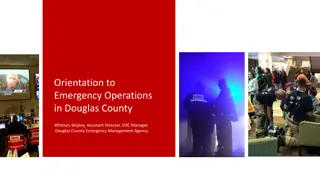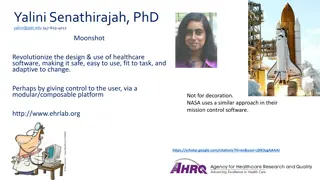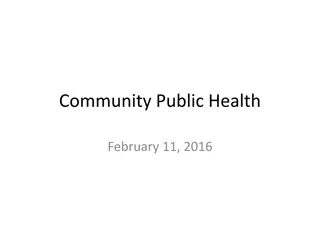
Shifting Focus: Health Information Technology in Low- to Middle-Income Countries
Transforming the role of Health Information Technology (HIT) in low- and middle-income countries to enhance healthcare delivery rather than just data collection. Initiatives by the Center for Health Informatics for the Underserved and Global Health Informatics Institute aim to support process-centric HIT interventions, training the next generation of global health informaticians with problem-driven development skills.
Uploaded on | 1 Views
Download Presentation

Please find below an Image/Link to download the presentation.
The content on the website is provided AS IS for your information and personal use only. It may not be sold, licensed, or shared on other websites without obtaining consent from the author. If you encounter any issues during the download, it is possible that the publisher has removed the file from their server.
You are allowed to download the files provided on this website for personal or commercial use, subject to the condition that they are used lawfully. All files are the property of their respective owners.
The content on the website is provided AS IS for your information and personal use only. It may not be sold, licensed, or shared on other websites without obtaining consent from the author.
E N D
Presentation Transcript
Reshaping the Role of Health Information Technology in Low- and Middle-Income Countries Challenge: Over the past 15 years international aid organizations have made large investments in health information technology (HIT) in many low- and middle-income countries. Sadly these investments have largely focused on improving the quality and timeliness of data for monitoring and evaluation purposes, in many cases relying on the severely limited pool of health workers to capture data. This has for the most part taken valuable time away from actual healthcare delivery. Approach: The Mission of the Center for Health Informatics for the Underserved and the newly established Global Health Informatics Institute is to shift the focus of these investments to supporting process-centric HIT interventions that reduce both the cognitive as well as physical burden of healthcare delivery while collecting data as a transparent byproduct of system use. We aim to achieve this through focused training and service learning opportunities and through the development of demonstration sites where reference implementations of new process-centric approaches can be closely studied and refined. Gerry Douglas, PhD Assistant Professor of Biomedical Informatics Assistant Professor of Health Policy & Management Director, Center for Health Informatics for the Underserved Founder, Global Health Informatics Institute Email: gdouglas@pitt.edu Cell: 1-412-478-4472 https://scholar.google.com/citations?user=F5bO1i8AAAAJ
The Global Health Informatics Institute Developing Solutions at the Intersection of Science, Engineering and Global Health Residential Training Center: Lilongwe, Malawi Capacity and Resources: Training Classroom with full A/V support Three break-out rooms for group work Innovation Electronics workshop with prototyping capabilities, including circuit board production Steel, plastic and wood fabrication capabilities Computer Numerical Control (CNC) Router, Plasma Cutter & 3D Printer for mechanical prototyping Goal: Train the next generation of global health informaticians with emphasis on problem-driven development and building product ownership skills Approach: Custom curriculum developed through 18 years of working in the global health informatics space Short courses for professional students Tightly-coupled classroom and field- based training to create a more comprehensive learning experience Accommodation Accommodation for up to 16 residential trainees and three faculty members On-site catering & laundry service
Key publications Douglas GP, Gadabu OJ, Joukes S, Mumba S, McKay MV, Ben-Smith A, Jahn A, Schouten EJ, Landis-Lewis Z, van Oosterhout JJ, Allain TJ, Berger SD, Harries AD, Chimbwandira F. Using touchscreen electronic medical record systems to support and monitor national scale-up of antiretroviral therapy in Malawi. PLoS medicine. 2010 Aug 10; 7 (8). PMCID: PMC2919419 Allain TJ, van Oosterhout JJ, Douglas GP, Joukes S, Gadabu OJ, Darts C, Kapur A, Harries AD. Applying lessons learnt from the DOTS Tuberculosis Model to monitoring and evaluating persons with diabetes mellitus in Blantyre, Malawi. Tropical medicine & international health: TM & IH. 2011 Jun 27; 16 (9):1077-84. PMID: 21702868 Driessen J, Cioffi M, Alide N, Landis-Lewis Z, Gamadzi G, Gadabu OJ, Douglas G. Modeling return on investment for an electronic medical record system in Lilongwe, Malawi. Journal of the American Medical Informatics Association: JAMIA. 2012 Nov 9. PMCID: PMC3721156 Fisher AM, Mtonga TM, Espino JU, Jonkman LJ, Connor SE, Cappella NK, Douglas GP. User- centered design and usability testing of RxMAGIC: a prescription management and general inventory control system for free clinic dispensaries. BMC Health Serv Res. 2018 Sep 10;18(1):703. doi: 10.1186/s12913-018-3517-8. PMID: 30200939 PMCID: PMC6131751 Mtonga TM, Choonara FE, Espino JU, Kachaje C, Kapundi K, Mengezi TE, Mumba SL, Douglas GP. Design and implementation of a clinical Laboratory Information System. African Journal of Laboratory Medicine, 2019. 8 (1), 1-7. PMID: 31745456 PMCID: PMC6852617
Research Funding Coaching and Training Support for Ministry of Health Staff in Ethiopia on Applied Global Health Informatics. 10/20/2017 - 12/31/2020, Bill and Melinda Gates Foundation $350,000 Developing an Electronic Register to Support Birth and Death Registration in Malawi. 04/01/2017 - 03/31/2019, Bloomberg Philanthropies $104,474 Strengthening Implementation and Use of Effective Health Information Systems through Improved Governance, Design, Planning, Capacity Development, and Technical Implementation under the President's Emergency Plan for AIDS Relief. 04/01/2018 - 03/31/2019, US Centers for Disease Control & Prevention $105,289 Planned submission for 11/20 Optimizing laboratory testing order entry and results review in a low- and middle- income country inpatient setting. 06/01/2021 12/31/2024, National Institutes of Health R01 $726,347
2020 Moonshot Improving malaria management in low- and middle income countries through a package of health information technology and medical informatics interventions Current clinical care model Malaria is the leading cause of death in children in Sub-Saharan Africa. Rural Health Posts staffed by health works with minimal training form the backbone of primary care. Clinical diagnostic accuracy is poor. Malaria rapid diagnostic tests have improved accuracy but are costly and frequently out of stock for weeks. Treatment decision is based on the test outcome. Proposed care pathway incorporating Bayesian model with decision support Signs and symptoms recorded electronically Using signs and symptoms collected by our touchscreen clinical workstation appliance our Bayesian model will provide a probability of malaria present/absent. Malaria rapid diagnostic tests would only be used within the broad region of uncertainty calculated by the model. Hypothesis: We believe that this approach will reduce the number of diagnostic tests consumed without compromising diagnostic accuracy.






















